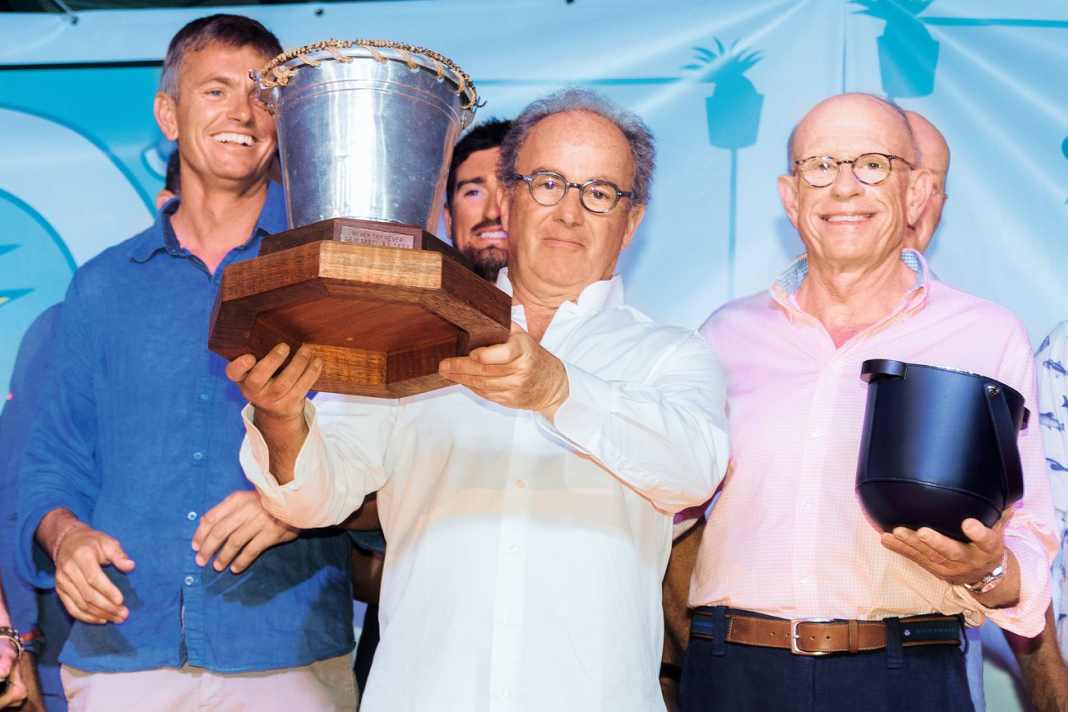





Hordes of professional sailors, including numerous America's Cup veterans, work on board the 30 superyachts at the start to ensure the owners' success. The fleet of superyachts is large and diverse. This year's fleet includes slips as well as ketch- and schooner-rigged sailing yachts with lengths between 27 and 56 metres. The speed differences between the boats are enormous, up to four minutes per nautical mile. In order to ensure a fair race, a division into different classes is necessary.
The smallest yacht in the 31st St Barth's Bucket The 27 metre long "Hummingbird", a Swan 90, and three Perini Navi giants share the title of largest yacht of the St. Barths Bucket 2025: the 56 metre long "Panthalassa", "Rosehearty" and "Burrasca", which all three compete in the "Les Grandes Dames" class.
Heterogeneous bucket fleet
The wide-ranging field was divided into four "conventional" bucket superyacht classes ("Les Gazelles", "Les Elegantes", "Les Mademoiselles" and "Les Grande Dames"), a Corinthian Spirit class without spinnaker (L'Esprit), a 90-foot class (Les Petites Dames) and, for the first time, a 100-foot racing class (Les Cent Pied). The two 100-footers, the Wallys "V" (ex-"Tango") and "Galateia", are scored twice in the Bucket Regatta: alone in Les Cent Pied and then again in combination with the three superyachts in Les Gazelles, the class reserved for the fastest performance-orientated cruising superyachts.
The division into the respective classes is based on the most precise assessment possible in terms of performance. The ratio of sail area to displacement plays a major role in the categorisation, as does the hull shape. Are they planing or displacement? A look at the designer and the shipyard also helps the race organisers to make an assessment. The Corinthian Spirit ships sail without a gennaker or spinnaker. The ORC rating ORCsy, which is optimised for superyachts, applies.
Precisely clocked Start times
The 100-foot class was due to start its competition on Thursday 13 March, but a lack of breeze led to a lay day. The two Wallys will complete two windward/leeward races, which will be scored according to IRC rules. From Friday to Sunday, they will then take part in the traditional bucket races (sailed according to ORCsy, better known as the "Superyacht Rule") and complete a coastal race each day together with the other participants.
The individual start times are organised in such a way that all yachts in a class finish together (as opposed to the entire fleet), whereby the class finishes are staggered for reasons of race safety. The distances between the individual classes depend on the courses, the wind strength and the class composition. This practice has proved its worth not only in terms of safe racing, but also in terms of fair racing, as different classes do not get in each other's way on the regatta course and slow each other down.
Even though the competitive spirit of the Bucket has increased significantly over the last decade, the spirit of the event remains the same. Not only the stewards of the exclusive event (the Royal Huisman and Vitters shipyards), but also the other sponsors and all participants fight for this. No other event offers owners such a relaxed atmosphere among their peers. The focus is on socialising, lively dock parties and the legendary "Yacht Hop" cocktail contest on board the yachts.
Bucket began in Nantucket
The story of the "Bucket" did not begin in the Caribbean, but in 1986 off the island of Nantucket in the US state of Massachusetts. Roger James, the captain of the "Volador", and Peter Goldstein, the owner of the "Flying Goose", started a friendly race in which eight yachts took part. The teams had so much fun that over a drink or two at the bar, they agreed to sail for the bucket again in the coming years. The Bucket Regatta was born.
As the popularity of the event grew, so did the number of participants, which presented the organisers with increasingly complex challenges. After 15 successful years, it was decided to discontinue the Nantucket Bucket in order to preserve the original spirit and simplicity of the event. In 1995, the tradition was continued with the creation of the St Barths Bucket. Former participants of the Nantucket Bucket created the new format in the Caribbean. The regatta quickly developed into one of the best-known events for superyachts worldwide and combines the Caribbean lifestyle, perfect climate and the thrill of competition in a wonderful way.
Regatta courses around rocks and barrels
There are three regatta courses with different variations to choose from. On Friday, the eight classes will set off on the "Around The Island" course, sailing clockwise around St Barths. Depending on the wind strength, the course has a length of 16 to 25 nautical miles. On day 2 of the Bucket Race, the more complex course "Not so Wiggley" is on the agenda, which takes the 30 participants around the small islands off St Barthélemy in different variations. Length: 21-27 nautical miles. The course on Sunday 16 March, day 3, is called "Wrong Way Around" and takes the fleet anti-clockwise around the island of the rich.
It will soon become clear which owner will be able to hoist the coveted bucket this year.

